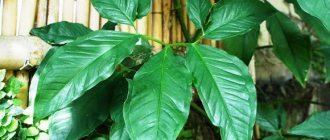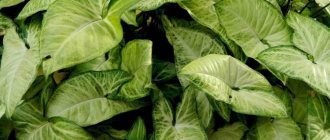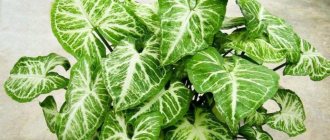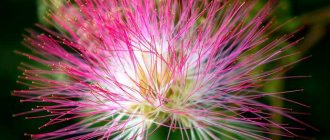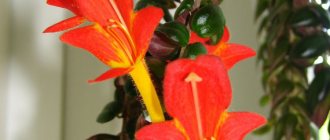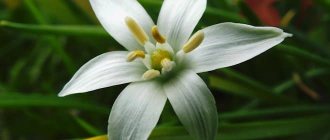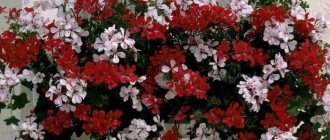Syngonium is a perennial evergreen vine with long stems with lateral shoots.
The shoots, creeping along the ground or entwining a vertical riser, are densely covered with beautiful large leaves, which have led to the wide popularity of the vine among flower growers.
The syngonium flower is ideal for a home where the owner wants to add some zest and fill the room with a rich palette of green. Following simple rules for caring for a tropical dweller will allow you to create a tropical corner in the interior of a city apartment.
Description of the plant
Liana-like culture belongs to the Araceae family, which has about 3,300 species and about 117 genera .
In the wild, the height of the vine can reach 20 m with a shoot width of 6 cm, and at home it varies from 1.5 to 2 m with a stem diameter of 1-2 cm.
Along the entire length of the shoot there are protruding nodes from which petiolar leaves develop, and a little lower there are aerial roots.
The green leaves are whole, heart-shaped or palmately divided and have different sizes. The location of the relief veins can be in the center or along the edge in the form of an edging. Depending on the variety, the leaf blade can be plain or variegated.
observe the flowering of a tropical vine only in its natural habitat . The beginning is noted at the end of spring, when cream-colored ears bloom, half hidden by a red or pink blanket.
The plant is characterized by cross-pollination, which results in cylindrical or ovoid fruits. Juicy fruits with a rich aroma are the food of monkeys, who distribute them over large areas.
Carefully! The plant is poisonous - work should be carried out with gloves, and children and pets should not be allowed to come into contact with the vine.
Plant propagation
At home, syngonium propagation is carried out by the vegetative method - cuttings or lateral shoots . It is carried out at any time of the year, but the development of spring and summer cuttings occurs much more intensively. To successfully use this technique, you should follow these steps:
- a part of the shoot with 2-3 internodes and aerial roots is cut off;
- the cutting is placed in warm water with activated carbon or in a soil mixture of sand, moss and peat;
- before rooting, they are covered with a film to reduce moisture loss and create an optimal temperature regime for soil and air - 25-27°C;
- after rooting, the cover is removed;
- seedlings are grown by analogy with the mother specimen.
Advice! Before placing the cutting in the ground for rooting, it is recommended to treat the cut with a root growth stimulator.
This video shows in detail how syngonium is propagated:
Features of growing indoors
Cultivating a plant in an apartment does not cause problems, but a number of nuances should be studied.
Landing
Syngonium is planted in small containers with drainage holes.
To obtain the splendor of the plant, several shoots are planted simultaneously in one pot.
This variety of vine can be used as a hanging plant if its stems are allowed to hang freely from the pot. Forming a crown will allow you to become the owner of a unique tree.
Advice! To get the shape of a tree, when planting in the ground, you should install a reliable support that will allow the vine to crawl upward.
Transfer
Young specimens are replanted every spring , but as they grow older, the interval between procedures increases. To ensure a successful transplant, the following steps must be followed:
- Place expanded clay at the bottom of the planting container as a drainage layer;
- pour loose and fertile soil with weak acidity on top - a soil mixture of turf, sand and peat;
- Using the transshipment technique to avoid damage to the roots, complete the replanting of the perennial.
Attention! An adult representative of the tropics needs to be replanted after roots appear from the drainage holes.
Care
Caring for the plant is quite simple. The love of gardeners for syngonium is caused by its unpretentiousness, rapid growth and vitality.
- Lighting. The flower requires a long period of diffused light. When placing the pot on the windows on the western or eastern side, we must not forget about protecting the vine from the scorching sun at its zenith.
- Temperature conditions. Throughout the year, with the exception of the winter season, when a decrease to 18°C is permissible, the optimal temperature is in the range from 22 to 25°C.
- Watering and humidity. Tropical liana needs high levels of humidity, systematic watering and spraying. Spraying of shoots is carried out daily with purified water at room temperature. The soil should be watered with the same water at short intervals: the soil should not dry out deeper than 3 cm. Regular moistening makes it easier for the plant to cope with air drought.
- Feeding. Fertilizers in the form of aqueous solutions of special mineral complexes for ornamental plants are applied under the crop at a distance from the stems. Fertilizing can be done from mid-spring to mid-autumn.
- Trimming. Lana has good pruning tolerance. The shoots are pinched for the first time after three pairs of leaves have formed. If necessary, you can shorten any process. If the stem has become too old and bare, then pruning promotes the development of young side shoots.
- Protection from diseases and pests. A native of the tropics has a well-developed immunity to diseases and pests. However, in case of improper care for a long time, it is affected by powdery mildew, and harmful insects such as spider mites, scale insects or mealybugs are observed on the foliage. If detected, protective measures should be taken - a hot shower up to 45C and treatment with the insecticide Actellik or Aktara.
Types of syngonium
The Syngonium genus is divided into twenty species, but only a few of them are grown indoors. The species used in indoor floriculture include several varieties bred by botanists.
Legleaf
This species in nature has petiolate leaves reaching a length of thirteen centimeters. As they age, the lance-shaped whole leaf blades begin to separate into lobes. The number of lobes on dissected leaves can reach eleven. The leaves are located on a stalk up to sixty centimeters long.
Foot-leaved syngonium has the following popular varieties:
Panda
Neon
Arrow
Pixie
- Panda - distinguished by yellowish spots on dark green leaves;
- Neon - almost white leaves with pink spots and veins;
- Pixie - has short stature and variegated leaves;
- Arrow - leaves with light streaks along the veins and large shoots.
Auricular (eared)
This species got its name from the shape of the leaves, which have a pair of small leaflets on both sides from the base. On branches 2-2.5 cm thick, aerial roots are densely formed in the internodes. Leaf sizes range from six to twenty centimeters. The leaves are bright green, with shiny skin. The leaf petioles reach forty centimeters.
This may be interesting: Yucca - reproduction, diseases and pests
Wendlanda
A medium-sized vine with petioles from 20 to 30 cm long, dark green leaves up to twenty centimeters. As they mature, the leaves are divided into three parts and have a velvety surface. Some varieties of Wendland syngonium have a silver-white stripe along the central vein.
Benefits, signs and superstitions
In city conditions, syngonium is an excellent solution for apartments and houses. It not only perfectly refreshes the interior, but filters air masses, eliminating the negative effects of hazardous elements.
The plant acts as a stabilizer of the level of humidity and oxygen saturation of the air in the room . But superstitious people often wonder whether it is possible to keep syngonium at home from the point of view of folk wisdom.
Among the people there are absolutely opposite signs and superstitions associated with keeping syngonium at home. According to the interpretation of some, if a person is sick, then the vine will help the owner regain strength and fight a very serious and sometimes incurable disease.
The plant helps strengthen morale and get rid of bad habits. When the owner is tormented by nightmares, it will protect his sleep. In other signs, syngonium is considered a muzhegon: male representatives in the housing where this plant grows do not get along, and the owners face the fate of an old maid. But these are just superstitions that have no justification.
So, keeping such an exotic plant in the house will not cause trouble for the owner, but it will amaze him with its varied colors and have a beneficial effect on health.
Why flowers are useful
There are many superstitions surrounding accomplices, and some directly contradict each other. Popular speculation is as follows:
- If you place the syngonium in a house where a sick person lives, the disease will subside. According to official medicine, this plant can make people with incurable pathological diseases get back on their feet.
- Syngonium is a good helper in the fight against bad habits. This plant enhances the personality of the owner.
- Lianas promote good physical and mental development. With their help, complex problems associated with education were overcome. A person begins to be interested in self-development, expands his horizons and is not afraid to express his opinion.
- Placing a pot of vines in your bedroom will give you peace of mind. Another feature of flowers: they help to avoid dwelling on unpleasant emotions.
- The plant has a contradictory character: in the house where the plant lives, women and men do not get along. However, according to many observations, in a happy family the flower takes a glorious position on the windowsill.
- In a house where no one accepts change and loves outdated things, a growing syngonium will be very useful.
To believe or not to believe in folk tales is a personal matter for everyone. What is really useful in syngonium is its ability to absorb vapors of harmful substances (formaldehyde, xylene, etc.). Flowers fill the room with oxygen and normalize air humidity. Plants that perform not only decorative, but also restoration functions will become worthy inhabitants of your apartment.
